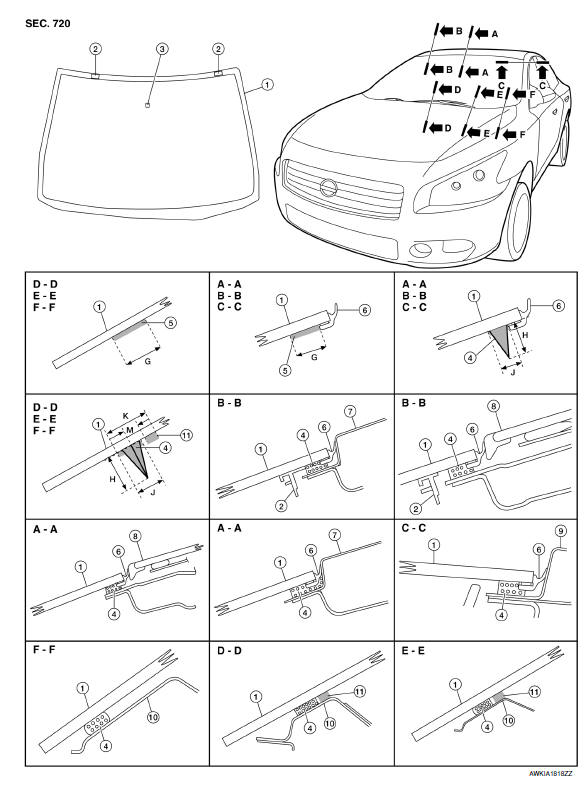Nissan Maxima Service and Repair Manual: Windshield glass
Exploded View

- Windshield glass
- Spacer
- Mirror base
- Adhesive
- Primer
- Windshield molding
- Metal roof
- Dual Panel Sunroof
- Front pillar
- Cowl top
- Rubber dam G.
- 16 mm (0.63 in) for top and sides 25 mm (0.98 in) for bottom
- 12 + 2, - 0 mm (0.47 + 0.08 - 0 in)
- 7 + 2, - 0 mm (0.28 + 0.08, - 0 in)
- 15 mm (0.59 in)
- 6.5 mm (0.26 in)
Removal and Installation
REMOVAL
- Remove the cowl top. Refer to EXT-21, "Removal and Installation".
- Remove roof side molding (if equipped).Refer to EXT-29, "Removal and Installation"
- Remove inside mirror. Refer to MIR-18, "Removal and Installation".
- Partially remove the headlining (front edge). Refer to INT-33, "Removal and Installation".
- After removing moldings, remove glass using piano wire or power cutting tool (A) and an inflatable pump bag (B).

- Apply a protective tape around the windshield glass to protect the painted surface from damage.
- If the windshield glass is to be reused, mark the body and the glass with mating marks.
WARNING: When cutting the glass from the vehicle, always wear safety glasses and heavy gloves to help prevent glass splinters from entering your eyes or cutting your hands.
CAUTION:
- Be careful not to scratch the glass when removing.
- Do not set or stand the glass on its edge. Small chips may develop into cracks.
- When the windshield glass is to be reused, do not use a cutting knife or power cutting tool.
INSTALLATION
Installation is in the reverse order of removal.
- Use a genuine Nissan Urethane Adhesive Kit (if available) or equivalent and follow the instructions furnished with it.
- While the urethane adhesive is curing, open a door window. This will prevent the glass from being forced out by passenger compartment air pressure when a door is closed.
- The molding must be installed securely so that it is in position and leaves no gap.
- Inform the customer that the vehicle should remain stationary until the urethane adhesive has completely cured (preferably 24 hours). Curing time varies with temperature and humidity.
WARNING:
- Keep heat and open flames away as primers and adhesive are flammable.
- The materials contained in the kit are harmful if swallowed, and may irritate skin and eyes. Avoid contact with the skin and eyes.
- Use in an open, well ventilated location. Avoid breathing the
vapors. They can be harmful if inhaled.
If affected by vapor inhalation, immediately move to an area with fresh air.
- - Driving the vehicle before the urethane adhesive has completely cured may affect the performance of the windshield in case of an accident.
CAUTION
- Do not use an adhesive which is past its usable term. Shelf life of this product is limited to six months after the date of manufacture. Carefully adhere to the expiration or manufacture date printed on the box.
- Keep primers and adhesive in a cool, dry place. Ideally, they should be stored in a refrigerator.
- Do not leave primers or adhesive cartridge unattended with their caps open or off.
- The vehicle should not be driven for at least 24 hours or until the urethane adhesive has completely cured. Curing time varies depending on temperature and humidity. The curing time will increase under lower temperature and lower humidity.
Inspection
Repairing water Leaks for Windshield
Leaks can be repaired without removing and reinstalling glass.
If water is leaking between the urethane adhesive material and body or glass, determine the extent of leakage.
This can be done by applying water to the windshield area while pushing glass outward.
To stop the leak, apply primer (if necessary) and then urethane adhesive to the leak point.
 Rear window glass
Rear window glass
Exploded View
Rear window glass
Spacer
Rubber dam (if equipped)
Primer
Rear window molding
Adhesive
16 +2, -0 mm (0.63 +0.08, - 0 in)
7+ 2, - 0 mm (0.28 + 0.08, - ...
Other materials:
Front door speaker
Description
The AV control unit sends audio signals to the front door speakers using the
front door speaker circuits.
Diagnosis Procedure
1.CONNECTOR CHECK
Check the AV control unit and speaker connectors for the following:
Proper connection
Damage
Disconnected or loose terminals
2. ...
Headlamp aiming adjustment
Description
PREPARATION BEFORE ADJUSTING
CAUTION: Do not use organic solvent
(thinner, gasoline etc.).
NOTE:
For details, refer to the regulations in your own country.
Perform aiming adjustment if the vehicle front body has been
repaired and/or the headlamp assembly has been replaced.
...
Precaution
PRECAUTIONS
Precaution for Supplemental Restraint System (SRS) "AIR BAG" and "SEAT BELT
PRE-TENSIONER"
The Supplemental Restraint System such as "AIR BAG" and "SEAT BELT
PRE-TENSIONER", used along
with a front seat belt, helps to reduce the risk or severity of injury to the
driver and fron ...
Nissan Maxima Owners Manual
- Illustrated table of contents
- Safety-Seats, seat belts and supplemental restraint system
- Instruments and controls
- Pre-driving checks and adjustments
- Monitor, climate, audio, phone and voice recognition systems
- Starting and driving
- In case of emergency
- Appearance and care
- Do-it-yourself
- Maintenance and schedules
- Technical and consumer information
Nissan Maxima Service and Repair Manual
0.0071

